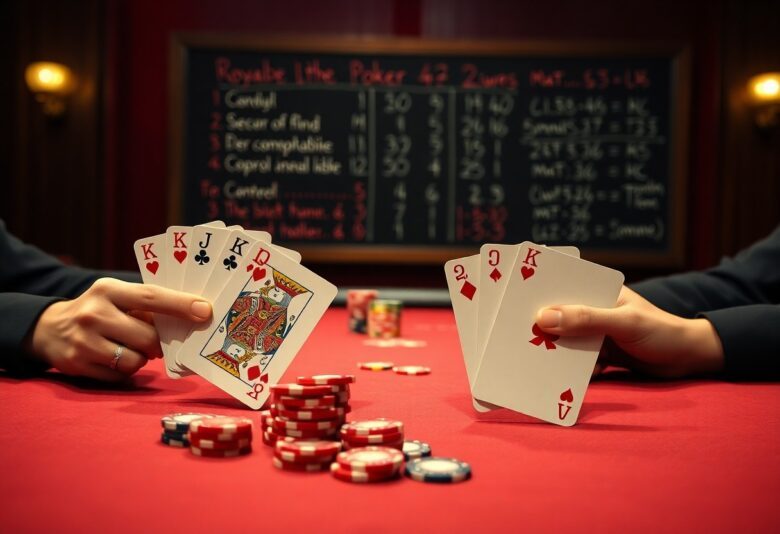Probability plays a vital role in poker, influencing every decision a player makes. By understanding the likelihood of different hands and the odds of winning in various situations, players can develop a more effective strategy that minimizes risk and maximizes potential rewards. This guide will investigate into the mathematical foundations of poker hands, illustrating how to apply these concepts to enhance your game and improve your overall performance at the table.
Understanding Poker Hands
Each player’s success in poker hinges on a deep understanding of various poker hands and their respective strengths. Knowing these hands enhances decision-making during play, whether in determining if a hand is worth continuing or folding at any point. Being well-versed in the hierarchy of hands allows players to make informed judgments based on the probabilities and potential outcomes of their cards against opponents’ potential holdings.
Classification of Poker Hands
Poker hands are classified based on the combination of cards a player holds, ranging from the high card, the weakest hand, to the royal flush, which is the strongest. The hierarchy proceeds through various combinations—such as pairs, three of a kind, straight, flush, and full house—each with its own rank. Familiarity with these classifications allows players to assess their hands quickly, impacting strategic choices and betting behavior.
The Importance of Hand Rankings
Hand rankings dictate the outcome of a game, serving as the fundamental basis for competition. Understanding these rankings ensures players can gauge their own hand strength compared to their opponents’. Mastery of this knowledge often influences betting patterns and psychological tactics in play, often guiding players toward aggressive or conservative strategies.
For example, recognizing that a straight beats a three of a kind can sway a player into either pushing their advantage or exercising caution in the face of potential threats. When a player grasps the nuances of hand rankings, they enhance their ability to bluff effectively or exploit others’ misjudgments, shifting the game dynamics in their favor. The strategic implications tied to hand rankings cannot be overstated, as they form the backbone of informed decision-making in high-stakes poker scenarios.
Basic Probability Concepts
Understanding basic probability concepts lays a foundation for effective poker strategy. Players frequently use probability to assess their chances of winning with certain hands or predicting an opponent’s potential range. Familiarity with these concepts enables informed decision-making, ultimately enhancing gameplay and increasing the likelihood of success at the tables.
What is Probability?
Probability quantifies the likelihood of a specific outcome occurring within a given set of circumstances. It is expressed numerically, typically ranging from 0 (impossible event) to 1 (certain event). In poker, players calculate the probability of drawing certain cards or completing a hand, helping to inform their betting and folding decisions.
Key Probability Terms
Familiarity with key probability terms enhances a player’s analytical skills. Terms like odds, expected value, and combinatorics are vital. Each term provides a framework that guides players in evaluating potential outcomes, calculating risks, and optimizing their strategies according to the mathematical probabilities of the game.
Understanding odds refers to the ratio of favorable outcomes to unfavorable ones, while expected value represents the anticipated value of a bet over time, accounting for potential wins and losses. Combinatorics involves calculating the various ways specific hands can be formed, which is crucial in assessing the strength of a player’s hand relative to the community cards. Each of these key terms contributes to a comprehensive grasp of probability, empowering players to make sharper decisions during gameplay.
Calculating Probabilities in Poker
Understanding probabilities in poker can significantly enhance gameplay and decision-making. By calculating the likelihood of various hands winning or losing, players can make informed bets, folds, and calls. For example, knowing that a flush draw offers approximately a 35% chance to complete can shape betting strategies and risk assessment during the game.
Winning vs. Losing Hands
In evaluating winning versus losing hands, specific ratios determine the potential outcomes of certain cards. Strong hands like pocket aces win against weaker hands about 85% of the time, while hands like 7-2 offsuit are among the lowest rankings. Understanding the relative strength of combinations fosters strategic decisions and adjusts aggression levels based on perceived odds.
Odds and Expected Value
Odds refer to the chances of specific outcomes, while expected value (EV) evaluates the potential financial outcome of decisions made. Positive EV indicates profitable plays over time, while negative EV highlights poor decisions that could deplete a player’s stack.
Calculating expected value involves assessing the odds of hitting your desired outcomes multiplied by the potential wins versus losses incurred from a bet. For instance, if the odds of completing a straight draw are 4:1, a bet of $10 with a potential win of $50 would yield an EV of $40 minus the $10 bet, providing a solid financial reason to pursue the hand. This mathematical approach helps players identify profitable situations and avoid costly mistakes by playing the odds strategically.
Applying Probability to Strategy
Incorporating probability into poker strategy allows players to make informed decisions based on statistical likelihoods rather than mere intuition. Understanding the odds associated with various hands significantly enhances a player’s ability to assess risks and rewards. By leveraging calculations from pre-flop to the river, players can adjust their betting patterns, bluffs, and overall gameplay to optimize their outcomes. This approach transforms poker from a game of chance into one of skill and strategy, where mathematical insights guide every decision at the table.
Adjusting Strategy Based on Hand Strength
Hand strength is a pivotal aspect influencing betting behavior. Players must assess their hand in conjunction with community cards and opponents’ actions to determine their potential for winning. For instance, a strong hand like a set or flush warrants aggressive betting to maximize profit, while a weak hand may call for cautious play or even folding. Utilizing probabilities to evaluate hand strength enables players to adjust their strategies dynamically, ensuring they’re capitalizing on favorable odds and avoiding costly mistakes.
The Role of Position in Probability
Position at the poker table significantly impacts a player’s strategic decisions. Being in a later position allows for greater insight into opponents’ actions, providing an edge in assessing likely hand strengths. A player in the cutoff or button position can exploit this advantage by making more informed bids. Conversely, early position demands a tighter strategy since fewer insights are available. Understanding the probabilities associated with positional play adds an necessary layer to strategy formulation, allowing players to navigate different scenarios effectively.
Position not only dictates when a player acts but also shapes the dynamics of the hand. For example, from a late position, a player can calculate the potential outcomes of earlier players’ actions and their corresponding probabilities, which enhances their decision-making. A player in late position can often afford to be more aggressive with weaker hands based on their assessment of opponents’ perceived strengths. This nuanced approach leads to strategically maximizing potential gains while minimizing exposure to risks inherent in early position play. Adjusting strategies based on position ultimately elevates a player’s ability to exploit probabilistic advantages effectively.
Common Mistakes in Poker Probability
Many players stumble in their poker journey by overlooking fundamental aspects of probability. These common mistakes often lead to unfavorable odds and poor decision-making at the table. Understanding these pitfalls—such as overvaluing hands and ignoring pot odds—can significantly improve strategic play, ensuring that decisions are more mathematically sound and less driven by emotion.
Overvaluing Hands
Players frequently overvalue their hands, believing a strong combination is unbeatable. This mindset can lead to stalemates where one overcommits to a hand that, statistically, is less favorable against potential opponents’ holdings. For instance, top pair with a weak kicker might seem formidable, but an opponent holding a set can easily dominate the scenario.
Ignoring Pot Odds
Ignoring pot odds is a common miscalculation in poker strategy, often resulting in significant financial losses. Pot odds represent the ratio of the current size of the pot to the cost of a contemplated call. Understanding these numbers allows players to make informed decisions about whether to call or fold. If the pot sits at $100 and you’re facing a $20 bet, your pot odds are 5:1. If your chances of hitting a drawing hand are better than this ratio, a call is justified. Conversely, failing to assess these odds can lead to costly calls when the likelihood of winning does not justify the investment.
Advanced Probability Techniques
Understanding advanced probability techniques enhances strategic decision-making in poker. Players can leverage mathematical insights to fine-tune their strategies, assess risks, and make more informed calls or folds during gameplay.
- Utilizing conditional probability to assess opponents’ hands.
- Calculating pot odds for more effective betting strategies.
- Applying expected value in various betting scenarios.
- Employing combinatorial analysis for better hand evaluations.
| Technique | Description |
|---|---|
| Conditional Probability | Calculating outcomes based on known variables. |
| Pot Odds | Evaluating the relationship between the current pot size and the bet size. |
| Expected Value | Determining the profitability of different betting scenarios. |
| Combinatorial Analysis | Assessing hand possibilities to predict opponent actions. |
Outs and Equity Calculations
Determining outs and equity calculates your chances of improving your hand. Counting outs involves identifying unseen cards that can enhance your position, while equity represents the probability of winning at showdown. For example, if you have four hearts and seek a flush, nine remaining hearts as outs would yield approximately a 35% chance to complete the flush by the river.
Using Probability in Bluffing Scenarios
Incorporating probability into bluffing strategies provides strategic depth. Players must evaluate their likelihood of success based on the situation, including board texture and opponents’ tendencies. For instance, bluffing in a dry board with fewer possible draws generally yields higher success rates compared to wet boards, where opponents may have many outs.
Successful bluffing integrates probability metrics with psychological insights. If you assess that your opponent has missed draws, the likelihood of a successful bluff increases. For instance, in a heads-up situation where your opponent shows weakness, positioning a well-timed bluff with a 40% estimated success rate becomes an attractive option, especially when pot odds align favorably. Engaging in such strategic maneuvers can shift the game’s momentum, rewarding calculated risks rather than mere chance.
Summing up
Upon reflecting, understanding poker hands in relation to probability significantly enhances a player’s strategic acumen. By utilizing mathematical principles, players can better assess their odds of winning, refine their decision-making processes, and ultimately improve their overall game. The integration of math into poker not only elevates the skill set of a player but also fosters a deeper appreciation for the complexities involved. Thus, harnessing these concepts provides a robust framework for approaching each hand with insight and calculated precision.
FAQ
Q: What are the different poker hands ranked from highest to lowest?
A: The ranked poker hands are: 1. Royal Flush 2. Straight Flush 3. Four of a Kind 4. Full House 5. Flush 6. Straight 7. Three of a Kind 8. Two Pair 9. One Pair 10. High Card
Q: How does probability affect decision-making in poker?
A: Probability helps players assess the likelihood of completing a hand or winning against opponents. By calculating the odds of drawing specific cards or forming winning hands, players can make informed decisions on betting, calling, or folding based on potential outcomes.
Q: Can mathematical strategies improve my poker game?
A: Yes, applying mathematical strategies such as expected value and pot odds can enhance decision-making. Understanding the probabilities of various hands and the potential payout relative to the risk can lead to more strategic play and better overall results.




